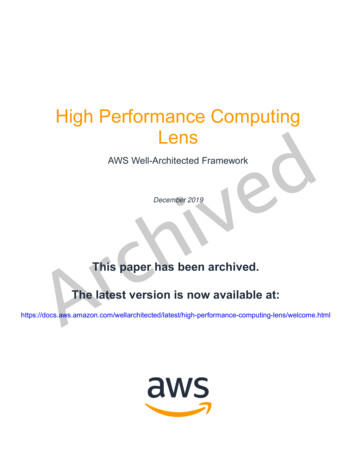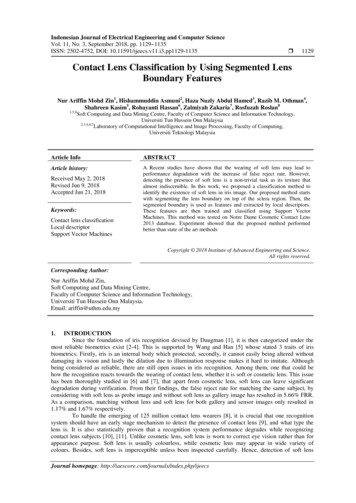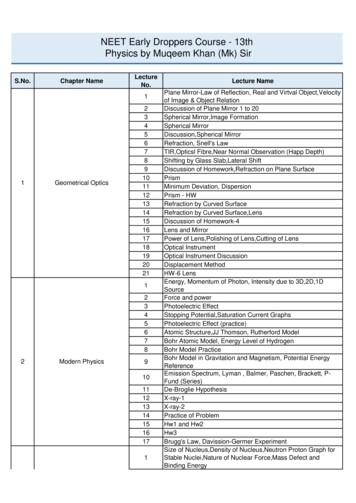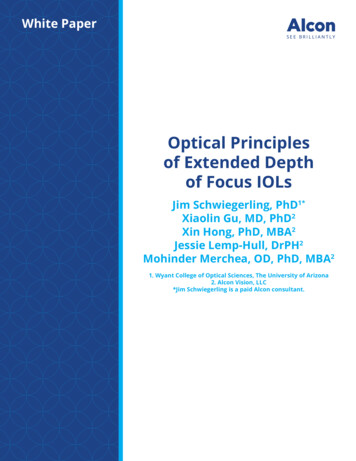
Transcription
High Performance ComputingLensdeAWS Well-Architected FrameworkvihDecember 2019crAThis paper has been archived.The latest version is now available est/high-performance-computing-lens/welcome.html
NoticesCustomers are responsible for making their own independent assessment of theinformation in this document. This document: (a) is for informational purposes only, (b)represents current AWS product offerings and practices, which are subject to changewithout notice, and (c) does not create any commitments or assurances from AWS andits affiliates, suppliers or licensors. AWS products or services are provided “as is”without warranties, representations, or conditions of any kind, whether express orimplied. The responsibilities and liabilities of AWS to its customers are controlled byAWS agreements, and this document is not part of, nor does it modify, any agreementbetween AWS and its customers.vihde 2019 Amazon Web Services, Inc. or its affiliates. All rights reserved.crA
ContentsIntroduction .1Definitions .2General Design Principles .3Scenarios .6Loosely Coupled Scenarios .8deTightly Coupled Scenarios .9Reference Architectures .10The Five Pillars of the Well-Architected Framework .20vihOperational Excellence Pillar .20Security Pillar.23Reliability Pillar .25Performance Efficiency Pillar .28crACost Optimization Pillar .36Conclusion .39Contributors .40Further Reading .40Document Revisions.40
AbstractThis document describes the High-Performance Computing (HPC) Lens for the AWSWell-Architected Framework. The document covers common HPC scenarios andidentifies key elements to ensure that your workloads are architected according to bestpractices.crAvihde
Amazon Web ServicesAWS Well-Architected Framework — High Performance Computing LensIntroductionThe AWS Well-Architected Framework helps you understand the pros and cons ofdecisions you make while building systems on AWS. 1 Use the Framework to learnarchitectural best practices for designing and operating reliable, secure, efficient, andcost-effective systems in the cloud. The Framework provides a way for you toconsistently measure your architectures against best practices and identify areas forimprovement. We believe that having well-architected systems greatly increases thelikelihood of business success.deIn this “Lens” we focus on how to design, deploy, and architect your High-PerformanceComputing (HPC) workloads on the AWS Cloud. HPC workloads run exceptionallywell in the cloud. The natural ebb and flow and bursting characteristic of HPC workloadsmake them well suited for pay-as-you-go cloud infrastructure. The ability to fine tunecloud resources and create cloud-native architectures naturally accelerates theturnaround of HPC workloads.vihFor brevity, we only cover details from the Well-Architected Framework that are specificto HPC workloads. We recommend that you consider best practices and questions fromthe AWS Well-Architected Framework whitepaper2 when designing your architecture.crAThis paper is intended for those in technology roles, such as chief technology officers(CTOs), architects, developers, and operations team members. After reading this paper,you will understand AWS best practices and strategies to use when designing andoperating HPC in a cloud environment.1
Amazon Web ServicesAWS Well-Architected Framework — High Performance Computing LensDefinitionsThe AWS Well-Architected Framework is based on five pillars: operational excellence,security, reliability, performance efficiency, and cost optimization. When architectingsolutions, you make tradeoffs between pillars based upon your business context. Thesebusiness decisions can drive your engineering priorities. You might reduce cost at theexpense of reliability in development environments, or, for mission-critical solutions, youmight optimize reliability with increased costs. Security and operational excellence aregenerally not traded off against other pillars.deThroughout this paper, we make the crucial distinction between loosely coupled –sometimes referred to as high-throughput computing (HTC) in the community – andtightly coupled workloads. We also cover server-based and serverless designs. Refer tothe Scenarios section for a detailed discussion of these distinctions.vihSome vocabulary of the AWS Cloud may differ from common HPC terminology. Forexample, HPC users may refer to a server as a “node” while AWS refers to a virtualserver as an “instance.” When HPC users commonly speak of “jobs,” AWS refers tothem as “workloads.”crAAWS documentation uses the term “vCPU” synonymously with a “thread” or a“hyperthread” (or half of a physical core). Don’t miss this factor of 2 when quantifyingthe performance or cost of an HPC application on AWS.Cluster placement groups are an AWS method of grouping your compute instancesfor applications with the highest network requirements. A placement group is not aphysical hardware element. It is simply a logical rule keeping all nodes within a lowlatency radius of the network.The AWS Cloud infrastructure is built around Regions and Availability Zones. ARegion is a physical location in the world where we have multiple Availability Zones.Availability Zones consist of one or more discrete data centers, each with redundantpower, networking, and connectivity, housed in separate facilities. Depending on thecharacteristics of your HPC workload, you may want your cluster to span AvailabilityZones (increasing reliability) or stay within a single Availability Zone (emphasizing lowlatency).2
Amazon Web ServicesAWS Well-Architected Framework — High Performance Computing LensGeneral Design PrinciplesIn traditional computing environments, architectural decisions are often implemented asstatic, one-time events, sometimes with no major software or hardware upgrades duringa computing system’s lifetime. As a project and its context evolve, these initial decisionsmay hinder the system’s ability to meet changing business requirements.It’s different in the cloud. A cloud infrastructure can grow as the project grows, allowingfor a continuously optimized capability. In the cloud, the capability to automate and teston demand lowers the risk of impact from infrastructure design changes. This allowssystems to evolve over time so that projects can take advantage of innovations as astandard practice.deThe Well-Architected Framework proposes a set of general design principles to facilitategood design in the cloud with high-performance computing: vihDynamic architectures: Avoid frozen, static architectures and cost estimatesthat use a steady-state model. Your architecture must be dynamic: growing andshrinking to match your demands for HPC over time. Match your architecturedesign and cost analysis explicitly to the natural cycles of HPC activity. Forexample, a period of intense simulation efforts might be followed by a reductionin demand as the work moves from the design phase to the lab. Or, a long andsteady data accumulation phase might be followed by a large-scale analysis anddata reduction phase. Unlike many traditional supercomputing centers, the AWSCloud helps you avoid long queues, lengthy quota applications, and restrictionson customization and software installation. Many HPC endeavors are intrinsicallybursty and well-matched to the cloud paradigms of elasticity and pay-as-you-go.The elasticity and pay-as-you-go model of AWS eliminates the painful choicebetween oversubscribed systems (waiting in queues) or idle systems (wastedmoney). Environments, such as compute clusters, can be “right-sized” for a givenneed at any given time.crAAlign the procurement model to the workload: AWS makes a range ofcompute procurement models available for the various HPC usage patterns.Selecting the correct model ensure that you are only paying for what you need.For example, a research institute might run the same weather forecastapplication in different ways:oAn academic research project investigates the role of a weather variablewith a large number of parameter sweeps and ensembles. Thesesimulations are not urgent, and cost is a primary concern. They are a great3
Amazon Web ServicesAWS Well-Architected Framework — High Performance Computing Lensmatch for Amazon EC2 Spot Instances. Spot Instances let you takeadvantage of Amazon EC2 unused capacity and are available at up to a90% discount compared to On-Demand prices. oDuring the wildfire season, up-to-the-minute local wind forecasts ensure thesafety of firefighters. Every minute of delay in the simulations decreasestheir chance of safe evacuation. On-Demand Instances must be used forthese simulations to allow for the bursting of analyses and ensure thatresults are obtained without interruption.oEvery morning, weather forecasts are run for television broadcasts in theafternoon. Scheduled Reserved Instances can be used to make sure thatthe needed capacity is available every day at the right time. Use of thispricing model provides a discount compared with On-Demand Instances.devihStart from the data: Before you begin designing your architecture, you musthave a clear picture of the data. Consider data origin, size, velocity, and updates.A holistic optimization of performance and cost focuses on compute and includesdata considerations. AWS has a strong offering of data and related services,including data visualization, which enables you to extract the most value fromyour data.crAAutomate to simplify architectural experimentation: Automation through codeallows you to create and replicate your systems at low cost and avoid theexpense of manual effort. You can track changes to your code, audit their impact,and revert to previous versions when necessary. The ability to easily experimentwith infrastructure allows you to optimize the architecture for performance andcost. AWS offers tools, such as AWS ParallelCluster, that help you get startedwith treating your HPC cloud infrastructure as code.Enable collaboration: HPC work often occurs in a collaborative context,sometimes spanning many countries around the world. Beyond immediatecollaboration, methods and results are often shared with the wider HPC andscientific community. It’s important to consider in advance which tools, code, anddata may be shared, and with whom. The delivery methods should be part of thisdesign process. For example, workflows can be shared in many ways on AWS:you can use Amazon Machine Images (AMIs), Amazon Elastic Block Store(Amazon EBS) snapshots, Amazon Simple Storage Service (Amazon S3)buckets, AWS CloudFormation templates, AWS ParallelCluster configurationfiles, AWS Marketplace products, and scripts. Take full advantage of the AWSsecurity and collaboration features that make AWS an excellent environment for4
Amazon Web ServicesAWS Well-Architected Framework — High Performance Computing Lensyou and your collaborators to solve your HPC problems. This helps yourcomputing solutions and datasets achieve a greater impact by securely sharingwithin a selective group or publicly sharing with the broader community. Use cloud-native designs: It is usually unnecessary and suboptimal to replicateyour on-premises environment when you migrate workloads to AWS. Thebreadth and depth of AWS services enables HPC workloads to run in new waysusing new design patterns and cloud-native solutions. For example, each user orgroup can use a separate cluster, which can independently scale depending onthe load. Users can rely on a managed service, like AWS Batch, or serverlesscomputing, like AWS Lambda, to manage the underlying infrastructure. Considernot using a traditional cluster scheduler, and instead use a scheduler only if yourworkload requires it. In the cloud, HPC clusters do not require permanence andcan be ephemeral resources. When you automate your cluster deployment youcan terminate one cluster and launch a new one quickly with the same ordifferent parameters. This method creates environments as necessary. Test real-world workloads: The only way to know how your productionworkload will perform in the cloud is to test it on the cloud. Most HPC applicationsare complex, and their memory, CPU, and network patterns often can’t bereduced to a simple test. Also, application requirements for infrastructure varybased on which application solvers (mathematical methods or algorithms) yourmodels use, the size and complexity of your models, etc. For this reason, genericbenchmarks aren’t reliable predictors of actual HPC production performance.Similarly, there is little value in testing an application with a small benchmark setor “toy problem.” With AWS, you only pay for what you actually use; therefore, itis feasible to do a realistic proof-of-concept with your own representative models.A major advantage of a cloud-based platform is that a realistic, full-scale test canbe done before migration. devihcrABalance time-to-results and cost reduction: Analyze performance using themost meaningful parameters: time and cost. Focus on cost optimization shouldbe used for workloads that are not time-sensitive. Spot Instances are usually theleast expensive method for non-time-critical workloads. For example, if aresearcher has a large number of lab measurements that must be analyzedsometime before next year’s conference, Spot Instances can help analyze thelargest possible number of measurements within the fixed research budget.Conversely, for time-critical workloads, such as emergency response modeling,cost optimization can be traded for performance, and instance type, procurementmodel, and cluster size should be chosen for lowest and most immediate5
Amazon Web ServicesAWS Well-Architected Framework — High Performance Computing Lensexecution time. If comparing platforms, it’s important to take the entire time-tosolution into account, including non-compute aspects such as provisioningresources, staging data, or, in more traditional environments, time spent in jobqueues.ScenariosHPC cases are typically complex computational problems that require parallelprocessing techniques. To support the calculations, a well-architected HPCinfrastructure is capable of sustained performance for the duration of the calculations.HPC workloads span traditional applications, like genomics, computational chemistry,financial risk modeling, computer aided engineering, weather prediction and seismicimaging, as well as emerging applications, like machine learning, deep learning, andautonomous driving. Still, the traditional grids or HPC clusters that support thesecalculations are remarkably similar in architecture with select cluster attributesoptimized for the specific workload. In AWS, the network, storage type, compute(instance) type, and even deployment method can be strategically chosen to optimizeperformance, cost, and usability for a particular workload.devihcrAHPC is divided into two categories based on the degree of interaction between theconcurrently running parallel processes: loosely coupled and tightly coupled workloads.Loosely coupled HPC cases are those where the multiple or parallel processes don’tstrongly interact with each other in the course of the entire simulation. Tightly coupledHPC cases are those where the parallel processes are simultaneously running andregularly exchanging information between each other at each iteration or step of thesimulation.With loosely coupled workloads, the completion of an entire calculation or simulationoften requires hundreds to millions of parallel processes. These processes occur in anyorder and at any speed through the course of the simulation. This offers flexibility on thecomputing infrastructure required for loosely coupled simulations.Tightly coupled workloads have processes that regularly exchange information at eachiteration of the simulation. Typically, these tightly coupled simulations run on ahomogenous cluster. The total core or processor count can range from tens, tothousands, and occasionally to hundreds of thousands if the infrastructure allows. Theinteractions of the processes during the simulation place extra demands on theinfrastructure, such as the compute nodes and network infrastructure.6
Amazon Web ServicesAWS Well-Architected Framework — High Performance Computing LensThe infrastructure used to run the huge variety of loosely and tightly coupledapplications is differentiated by its ability for process interactions across nodes. Thereare fundamental aspects that apply to both scenarios and specific design considerationsfor each. Consider the following fundamentals for both scenarios when selecting anHPC infrastructure on AWS: Network: Network requirements can range from cases with low requirements,such as loosely coupled applications with minimal communication traffic, to tightlycoupled and massively parallel applications that require a performant networkwith large bandwidth and low latency. Storage: HPC calculations use, create, and move data in unique ways. Storageinfrastructure must support these requirements during each step of thecalculation. Input data is frequently stored on startup, more data is created andstored while running, and output data is moved to a reservoir location upon runcompletion. Factors to be considered include data size, media type, transferspeeds, shared access, and storage properties (for example, durability andavailability). It is helpful to use a shared file system between nodes. For example,using a Network File System (NFS) share, such as Amazon Elastic File System(EFS), or a Lustre file system, such as Amazon FSx for Lustre. crAvihCompute: The Amazon EC2 instance type defines the hardware capabilitiesavailable for your HPC workload. Hardware capabilities include the processortype, core frequency, processor features (for example, vector extensions),memory-to-core ratio, and network performance. On AWS, an instance isconsidered to be the same as an HPC node. These terms are usedinterchangeably in this whitepaper.o deAWS offers managed services with the ability to access compute without theneed to choose the underlying EC2 instance type. AWS Lambda and AWSFargate are compute services that allow you to run workloads withouthaving to provision and manage the underlying servers.Deployment: AWS provides many options for deploying HPC workloads.Instances can be manually launched from the AWS Management Console. Foran automated deployment, a variety of Software Development Kits (SDKs) isavailable for coding end-to-end solutions in different programming languages. Apopular HPC deployment option combines bash shell scripting with the AWSCommand Line Interface (AWS CLI).7
Amazon Web ServicesAWS Well-Architected Framework — High Performance Computing LensoAWS CloudFormation templates allow the specification of applicationtailored HPC clusters described as code so that they can be launched inminutes. AWS ParallelCluster is open-source software that coordinates thelaunch of a cluster through CloudFormation with already installed software(for example, compilers and schedulers) for a traditional cluster experience.oAWS provides managed deployment services for container-basedworkloads, such as Amazon EC2 Container Service (Amazon ECS),Amazon Elastic Kubernetes Service (Amazon EKS), AWS Fargate, andAWS Batch.oAdditional software options are available from third-party companies in theAWS Marketplace and the AWS Partner Network (APN).deCloud computing makes it easy to experiment with infrastructure components andarchitecture design. AWS strongly encourages testing instance types, EBS volumetypes, deployment methods, etc., to find the best performance at the lowest cost.vihLoosely Coupled ScenariosA loosely coupled workload entails the processing of a large number of smaller jobs.Generally, the smaller job runs on one node, either consuming one process or multipleprocesses with shared memory parallelization (SMP) for parallelization within that node.crAThe parallel processes, or the iterations in the simulation, are post-processed to createone solution or discovery from the simulation. Loosely coupled applications are found inmany areas, including Monte Carlo simulations, image processing, genomics analysis,and Electronic Design Automation (EDA).The loss of one node or job in a loosely coupled workload usually doesn’t delay theentire calculation. The lost work can be picked up later or omitted altogether. The nodesinvolved in the calculation can vary in specification and power.A suitable architecture for a loosely coupled workload has the following considerations: Network: Because parallel processes do not typically interact with each other,the feasibility or performance of the workloads is not sensitive to the bandwidthand latency capabilities of the network between instances. Therefore, clusteredplacement groups are not necessary for this scenario because they weaken theresiliency without providing a performance gain.8
Amazon Web ServicesAWS Well-Architected Framework — High Performance Computing Lens Storage: Loosely coupled workloads vary in storage requirements and are drivenby the dataset size and desired performance for transferring, reading, and writingthe data. Compute: Each application is different, but in general, the application’s memoryto-compute ratio drives the underlying EC2 instance type. Some applications areoptimized to take advantage of graphics processing units (GPUs) or fieldprogrammable gate array (FPGA) accelerators on EC2 instances. Deployment: Loosely coupled simulations often run across many — sometimesmillions — of compute cores that can be spread across Availability Zones withoutsacrificing performance. Loosely coupled simulations can be deployed with endto-end services and solutions such as AWS Batch and AWS ParallelCluster, orthrough a combination of AWS services, such as Amazon Simple Queue Service(Amazon SQS), Auto Scaling, AWS Lambda, and AWS Step Functions.devihTightly Coupled ScenariosTightly coupled applications consist of parallel processes that are dependent on eachother to carry out the calculation. Unlike a loosely coupled computation, all processes ofa tightly coupled simulation iterate together and require communication with oneanother. An iteration is defined as one step of the overall simulation. Tightly coupledcalculations rely on tens to thousands of processes or cores over one to millions ofiterations. The failure of one node usually leads to the failure of the entire calculation.To mitigate the risk of complete failure, application-level checkpointing regularly occursduring a computation to allow for the restarting of a simulation from a known state.crAThese simulations rely on a Message Passing Interface (MPI) for interprocesscommunication. Shared Memory Parallelism via OpenMP can be used with MPI.Examples of tightly coupled HPC workloads include: computational fluid dynamics,weather prediction, and reservoir simulation.A suitable architecture for a tightly coupled HPC workload has the followingconsiderations: Network: The network requirements for tightly coupled calculations aredemanding. Slow communication between nodes results in the slowdown of theentire calculation. The largest instance size, enhanced networking, and clusterplacement groups are required for consistent networking performance. Thesetechniques minimize simulation runtimes and reduce overall costs. Tightlycoupled applications range in size. A large problem size, spread over a large9
Amazon Web ServicesAWS Well-Architected Framework — High Performance Computing Lensnumber of processes or cores, usually parallelizes well. Small cases, with lowertotal computational requirements, place the greatest demand on the network.Certain Amazon EC2 instances use the Elastic Fabric Adapter (EFA) as anetwork interface that enables running applications that require high levels ofinternode communications at scale on AWS. EFA’s custom-built operatingsystem bypass hardware interface enhances the performance of interinstancecommunications, which is critical to scaling tightly coupled applications. Storage: Tightly coupled workloads vary in storage requirements and are drivenby the dataset size and desired performance for transferring, reading, and writingthe data. Temporary data storage or scratch space requires specialconsideration. Compute: EC2 instances are offered in a variety of configurations with varyingcore to memory ratios. For parallel applications, it is helpful to spread memoryintensive parallel simulations across more compute nodes to lessen the memoryper-core requirements and to target the best performing instance type. Tightlycoupled applications require a homogenous cluster built from similar computenodes. Targeting the largest instance size minimizes internode network latencywhile providing the maximum network performance when communicatingbetween nodes. decrAvihDeployment: A variety of deployment options are available. End-to-endautomation is achievable, as is launching simulations in a “traditional” clusterenvironment. Cloud scalability enables you to launch hundreds of large multiprocess cases at once, so there is no need to wait in a queue. Tightly coupledsimulations can be deployed with end-to-end solutions such as AWS Batch andAWS ParallelCluster, or through solutions based on AWS services such asCloudFormation or EC2 Fleet.Reference ArchitecturesMany architectures apply to both loosely coupled and tightly coupled workloads andmay require slight modifications based on the scenario. Traditional, on-premisesclusters force a one-size-fits-all approach to the cluster infrastructure. However, thecloud offers a wide range of possibilities and allows for optimization of performance andcost. In the cloud, your configuration can range from a traditional cluster experience witha scheduler and login node to a cloud-native architecture with the advantages of costefficiencies obtainable with cloud-native solutions. Five reference architectures arebelow:10
Amazon Web ServicesAWS Well-Architected Framework — High Performance Computing Lens1. Traditional cluster environment2. Batch-based architecture3. Queue-based architecture4. Hybrid deployment5. Serverless workflowTraditional Cluster EnvironmentdeMany users begin their cloud journey with an environment that is similar to traditionalHPC environments. The environment often involves a login node with a scheduler tolaunch jobs.vihA common approach to traditional cluster provisioning is based on an AWSCloudFormation template for a compute cluster combined with customization for auser’s specific tasks. AWS ParallelCluster is an example of an end-to-end clusterprovisioning capability based on AWS CloudFormation. Although the complexdescription of the architecture is hidden inside the template, typical configuration optionsallow the user to select the instance type, scheduler, or bootstrap actions, such asinstalling applications or synchronizing data. The template can be constructed andexecuted to provide an HPC environment with the “look and feel” of conventional HPCclusters, but with the added benefit of scalability. The login node maintains thescheduler, shared file system, and running environment. Meanwhile, an automaticscaling mechanism allows additional instances to spin up as jobs are submitted to a jobqueue. As instances become idle, they are automatically terminated.crAA cluster can be deployed in a persistent configuration or treated as an ephemeralresource. Persistent clusters are deployed with a login instance and a compute fleet thatcan either be a fixed sized, or tied to an Auto Scaling group which increases anddecreases the compute fleet depending on the number of submitted jobs. Persistentclusters always have some infrastructure running. Alternatively, clusters can be treatedas ephemeral where each workload runs on its own cluster. Ephemeral clusters areenabled by automation. For example, a bash script is combined with the AWS CLI, or aPython script with the AWS SDK provides end-to-end case automation. For each case,resources are provisioned and launched, data is placed on the nodes, jobs are runacross multiple nodes, and the case output is either retrieved automatically or sent toAmazon S3. Upo
Amazon Web Services AWS Well-Architected Framework — High Performance Computing Lens 1 Introduction The AWS Well-Architected Framework helps you understand the pros and cons of decisions you make while building systems on AWS. 1 Use the Framework to learn architectural best practices for designing and operating reliable, secure, efficient, and










